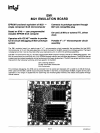
ICE·49
Memory Mapping
The
8049,
8748 and 8048 contain internal program and
data memory. Both program and data memory can be
expanded using external memory devices.
Internal Memory - When the MCS-48 microcomputer is
replaced
by
the ICE-49 socKet in a system, the ICE-49
module supplies static
RAM
memory
as
a replacement
for the internal microcomputer memory. The
ICE-49
module has enough
RAM
memory available
to
emulate
up
to
the total 4K control memory capability
of
the sys-
tem_
The ICE-49 module also provides for up
to
384
bytes
of
data memory.
External Memory - The ICE-49 module separates
replacement control memory into sixteen 256-byte
blocKs. Replacement external data memory consists
of
one 256-byte block. Each block of memory can
be
de-
fined separately as supplied
by
the user system
or
sup-
plied
by the ICE-49 module. The user may assign ICE-49
equivalent memory
to
take the place of external memory
not yet supplied
in
his system.
Symbolic Debugging
ICE-49 software provides symbolic definition
of
all
MCS-48
registers, flags, and selected MCS-48 pins.
Symbolically defined pseudo registers provide access
to the sense of
MCS-48
flip
flops which enable time,
counter, interrupt, and
flag-01lIag-1 options. In addition,
the user may reference locations
in
program and data
memory, or their contents,
symbolically. The user sym-
bol table
generated along with the object file during a
program assembly may be loaded
to
Intellec memory
for
access during emulation. The user is encouraged to add
to
this symbol table any additional symbolic values
for
memory addresses, constants,
or
variables he may find
useful during system debugging.
Symbols may be sub-
stituted for numeric values in any of the ICE-49 com-
mands. Symbolic reference is a great advantage to the
system designer. He is no longer burdened
with
the
need to
recall
or
look up those addresses
of
key loca-
tions in his program that can change with each assem-
bly.
Meaningful symbols from his source program may
be
used instead. For example, the command:
GO
FROM .START TILL XDATA.
RSLT
WRITTEN
begins execution of the program at the address refer-
enced by the label START in the designers assembly
program. A breakpoint is set to occur the first time the
microprocessor writes to the external data memory
location referenced
by
RSL
T.
The designer does not
have to
be
concerned with the physical locations
of
START and
RSL
T.
The ICE-49 software driver supplies
them automatically from information stored
in
the
symbol table.
Hardware
The ICE-49 module is a microcomputer system utilizing
Intel's 8049
or
804818748
microcomputer
as
its nucleus.
The
8049 provides the 8049, 8039 emulation character-
istics. The
804818748
provides the
8748180481803518021
emulation characteristics. The ICE-49 module uses
an
10-15
Intel
8080
to
communicate with the Intellec host pro-
cessor via a common memory space. The 8080 also con-
trols
an
internallCE-49 bus for intramodule communica-
tion. ICE-49 hardware consists of
two
PC
boards, the
controller board, and the emulator board,
all
of
which
reside in the
Intellec chassis. A cable interfaces the
ICE-49 boards to the MCS-48 system. The cable ter-
minates
in
a MCS-48 pin compatible plug which
replaces any
MCS-48 device in the user system. The
ICE-49 module block diagram is shown in Figure
1.
Real-Time Trace
Trace Buffer - While the ICE-49 module is executing
the user program, it is monitoring port, program
counter, data, and status lines.
Values
for
each instruc-
tion cycle executed are stored in a 255 x
44
real-time
RAM
trace buffer. A resetable timer resident on the con-
troller
board counts instruction cycles.
Controller Board
The ICE-49 module talks to the Intellec system
as
a
peripheral device. The controller board receives
com-
mands from the Intellec system and responds through
the parameter block.
Three 15-bit hardware breakpoint
registers are
available for loading by the user. While in
emUlation mode, a hardware comparator is constantly
monitoring address and status
lines
for
a match
to
ter-
minate
an
emulation. The breakpoint registers provide a
signal when a match is detected. The user may disable
the emulation break capability and use the signal
to
syn-
chronize other debug tools. The controller board returns
real-time trace data,
MCS-48
register, flag, and pin
values, and
ICE-49
status information,
to
a control block
in the Intellec system when emulation is terminated.
This information is
available
to
the user through the
ICE-49 interrogation commands. Error conditions, when
present, are automatically displayed on the
Intellec
system console. The controller board also contains
static
RAM
memory, which can be used to emulate
MCS-48 program and data memory in real time. 4K of
memory is
available in sixteen 256-byte pages to emu-
late MCS-48
PROM
or
PROM
program memory. A
256-
byte page of data memory is available
to
access in place
of
MCS-48 external data memory. The controller board
address map directs the
ICE-49 module
to
access either
replacement
ICE-49
memory
or
actual user system ex-
ternal memory
in
256-byte segments based
on
informa-
tion provided
by
the user.
Emulator Board
The emulator board contains the 8049* and peripheral
logiC required to emulate the MCS-48 device
in
the user
system. A software
selectable 6 MHz
or
3 MHz
clock
drives the emulated MCS-48 device. This
clock
can
be
disabled and replaced with a user supplied TTL
clock
in
the user system.
·Use
8048 with internal monitor program when emulating
8748/80481
803518021.
AFN-01103A-03


















